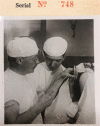Dr. Howard A. Kelly's The Stereo Clinic: health science pedagogy and the egalitarian future of 3D clinical visualization
- PMID: 35440906
- PMCID: PMC9014918
- DOI: 10.5195/jmla.2022.1450
Dr. Howard A. Kelly's The Stereo Clinic: health science pedagogy and the egalitarian future of 3D clinical visualization
Abstract
This article situates emerging three-dimensional (3D) visualization technologies in the health sciences within the broader historical context of the stereoscope. Although 3D visualization technologies enhance pedagogy and deepen student engagement, they are generally cost-prohibitive and therefore inaccessible for many institutions. In light of this issue, the authors consider the work of American gynecologist and founding member of The Johns Hopkins Hospital in Baltimore, Maryland, Dr. Howard Atwood Kelly (1858-1943). A monumental work, Kelly's The Stereo Clinic is a multivolume publication whose focal point was the stereoscope, an image-viewing device that can be seen as a prototype for present-day 3D technologies. Each installment presents a step-by-step overview of a specific surgical procedure using a didactic narrative and corresponding stereoscopic images that illustrate the clinical practices. Significantly, Kelly understood The Stereo Clinic as an egalitarian project that provided high-quality educational resources to students and practicing physicians who did not have access to world-class clinical suites and teaching institutions. Furthermore, he viewed The Stereo Clinic as a remedy to the commonplace frustrations of medical education, such as crowded surgical suites, and the hazards of in-person observation. The Stereo Clinic is an important case study because it reveals a medical profession at the turn of the twentieth century preoccupied with 3D visualization. Inventive clinicians such as Kelly did not only advocate for this technology on the strength of its pedagogical value; they also articulated the equalitarian nature of this medium and produced 3D technology accessible to a wide audience.
Keywords: 3D; health sciences education; history of medicine; pedagogy; stereoscope; stereoscopic imagery.
Copyright © 2022 Sebastian C. Galbo, Keith C. Mages.
Figures



References
-
- Jacquesson T, Simon E, Dauleac C, Margueron L, Robinson P, Mertens P. Stereoscopic three-dimensional visualization: interest for neuroanatomy teaching in medical school. Surg Radiol Anat. 2020;42(6):719–27. - PubMed
-
- Meyer ER, Cui D. Anatomy visualizations using stereopsis: assessment and implication of stereoscopic virtual models in anatomical education. Adv Exp Med Biol. 2020;1235:117–30. - PubMed
-
- Chhaya N, Helmy O, Piri N, Palacio A, Schaal S. Comparison of 2D and 3D Video displays for teaching vitreoretinal surgery. Retina. 2018;38(8):1556–61. - PubMed
Publication types
MeSH terms
LinkOut - more resources
Full Text Sources
